Roderic O'Conor (1860-1940) Landscape with Red Haystacks (1932) Oil on board, 38 x 46cm (15 x 18'') Exhibited: Possibly Copenhagen, Winkel and Magnussen, Gauguin Og Hans Venner (Gauguin and His Friends), 1956, (104) as Landskab med Kornstakke Provenance: Mr. J. P Reihill, Deepwell, Blackrock, Co. Dublin; His sale, these rooms, October 1st 2014, Lot 98; Private collection, Dublin Literature: Roderic O'Conor 1860 - 1940, Jonathan Benington, Dublin, 1992, Cat. No. 302, p.225 In 1956, sixteen years after his death in France, a painting by O'Conor was included in an exhibition titled ''Gauguin and His Friends'' which was assembled in Copenhagen by the auction house, Winkel and Magnussen. The similarity of subject matter between O'Conor's painting in that exhibition, Landscape with Cornstack, and Landscape with Red Haystacks suggests a possible link between them, but this has not been positively verified. Of all the rural sites made famous by French artists in the mid-nineteenth century, the most significant was the small village of Barbizon, situated on the edge of the great forest of Fontainebleau and a short journey from Paris. Barbizon had attracted landscape artists such as Millet, Rousseau, Daubigny, Dupré and Corot, who were drawn by the beauty of the forest and the dappled light which filtered through the trees. In 1932, Roderic O'Conor at the age of seventy-two, accompanied by his model and close companion, Renée Honta, left Paris temporarily to paint in the country, choosing to stay at Chailly-en-Bière rather than at Barbizon, which had become a popular tourist destination. Apart from a visit to Cassis in the summer of 1913, most of O'Conor's painting activity in Paris had been centered on studio-based subject matter and he probably felt the need to return to landscape themes and a closer connection to nature. Chailly was just three kilometres from Barbizon and provided a more tranquil and suitable location for his needs at that time. There was also an artists' inn at Chailly, called L'Auberge du Cheval Blanc, whose proprietor had developed a reputation for being sympathetic to the activities of visiting artists who came to paint in the Barbizon environment. The dining room at the inn was filled with paintings donated by artists in lieu of payment for their accommodation. Some of O'Conor's friends who were in contact with him queried his decision to paint in the Barbizon area at Chailly, claiming that it had lost its relevance as an artists' colony and that the area had become a magnet for ill-informed tourists. Even his friend Joseph Milner-Kite- who had studied with him in Antwerp, suggested that he might be back on the bus to Paris within a few days. Chailly's location on the fertile plain of Bière and its distinctive flat landscape provided the background for several O'Conor paintings in which haystacks became the primary subject matter. He may have been influenced by Monet's 1890-91 grainstack series painted in Normandy at Giverny. Whereas Monet was exploring the effects of light and seasonal change upon a variety of grainstacks, O'Conor appears to have only been interested in their shapes, the colors and their relationship to the surrounding landscape. O'Conor was in the last decade of his life when he painted Landscape with Red Haystacks. The scene is lightly painted with well diluted oil pigment, quickly sketched as if to capture the immediacy of the moment. The tracks in the field lead the viewer into the composition and hint at recent activity, probably associated with building the haystacks, which are set against a belt of dark green trees running across the picture plane in the center of the painting. The blue-gray pigment which O'Conor introduced into the upper right corner creates a darkened sky and suggests an impending storm. Some of O'Conor's friends who were in contact with him by letter queried his decision to paint in the Barbizon area at Chailly, claiming that it was no longer relevant as an artists
Roderic O'Conor (1860-1940) Landscape with Red Haystacks (1932) Oil on board, 38 x 46cm (15 x 18'') Exhibited: Possibly Copenhagen, Winkel and Magnussen, Gauguin Og Hans Venner (Gauguin and His Friends), 1956, (104) as Landskab med Kornstakke Provenance: Mr. J. P Reihill, Deepwell, Blackrock, Co. Dublin; His sale, these rooms, October 1st 2014, Lot 98; Private collection, Dublin Literature: Roderic O'Conor 1860 - 1940, Jonathan Benington, Dublin, 1992, Cat. No. 302, p.225 In 1956, sixteen years after his death in France, a painting by O'Conor was included in an exhibition titled ''Gauguin and His Friends'' which was assembled in Copenhagen by the auction house, Winkel and Magnussen. The similarity of subject matter between O'Conor's painting in that exhibition, Landscape with Cornstack, and Landscape with Red Haystacks suggests a possible link between them, but this has not been positively verified. Of all the rural sites made famous by French artists in the mid-nineteenth century, the most significant was the small village of Barbizon, situated on the edge of the great forest of Fontainebleau and a short journey from Paris. Barbizon had attracted landscape artists such as Millet, Rousseau, Daubigny, Dupré and Corot, who were drawn by the beauty of the forest and the dappled light which filtered through the trees. In 1932, Roderic O'Conor at the age of seventy-two, accompanied by his model and close companion, Renée Honta, left Paris temporarily to paint in the country, choosing to stay at Chailly-en-Bière rather than at Barbizon, which had become a popular tourist destination. Apart from a visit to Cassis in the summer of 1913, most of O'Conor's painting activity in Paris had been centered on studio-based subject matter and he probably felt the need to return to landscape themes and a closer connection to nature. Chailly was just three kilometres from Barbizon and provided a more tranquil and suitable location for his needs at that time. There was also an artists' inn at Chailly, called L'Auberge du Cheval Blanc, whose proprietor had developed a reputation for being sympathetic to the activities of visiting artists who came to paint in the Barbizon environment. The dining room at the inn was filled with paintings donated by artists in lieu of payment for their accommodation. Some of O'Conor's friends who were in contact with him queried his decision to paint in the Barbizon area at Chailly, claiming that it had lost its relevance as an artists' colony and that the area had become a magnet for ill-informed tourists. Even his friend Joseph Milner-Kite- who had studied with him in Antwerp, suggested that he might be back on the bus to Paris within a few days. Chailly's location on the fertile plain of Bière and its distinctive flat landscape provided the background for several O'Conor paintings in which haystacks became the primary subject matter. He may have been influenced by Monet's 1890-91 grainstack series painted in Normandy at Giverny. Whereas Monet was exploring the effects of light and seasonal change upon a variety of grainstacks, O'Conor appears to have only been interested in their shapes, the colors and their relationship to the surrounding landscape. O'Conor was in the last decade of his life when he painted Landscape with Red Haystacks. The scene is lightly painted with well diluted oil pigment, quickly sketched as if to capture the immediacy of the moment. The tracks in the field lead the viewer into the composition and hint at recent activity, probably associated with building the haystacks, which are set against a belt of dark green trees running across the picture plane in the center of the painting. The blue-gray pigment which O'Conor introduced into the upper right corner creates a darkened sky and suggests an impending storm. Some of O'Conor's friends who were in contact with him by letter queried his decision to paint in the Barbizon area at Chailly, claiming that it was no longer relevant as an artists
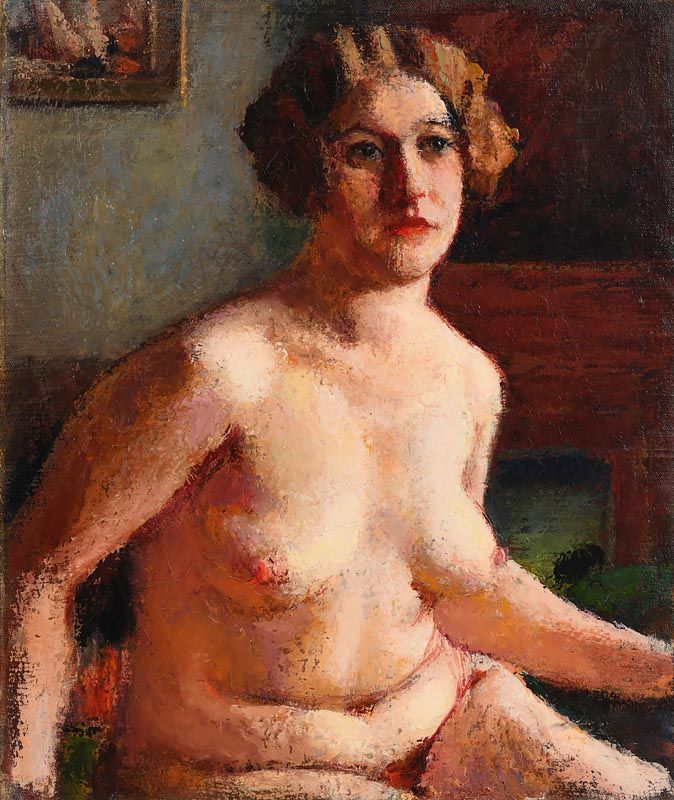

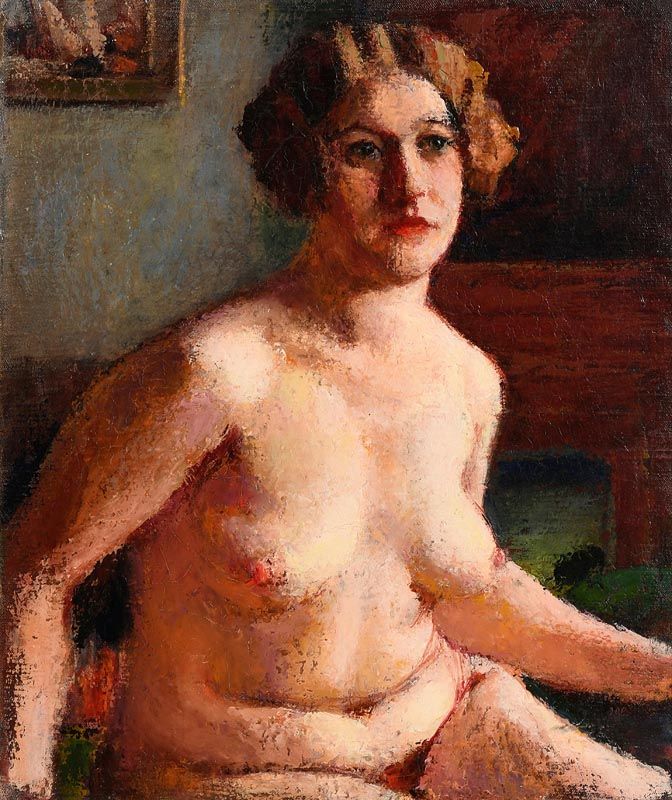

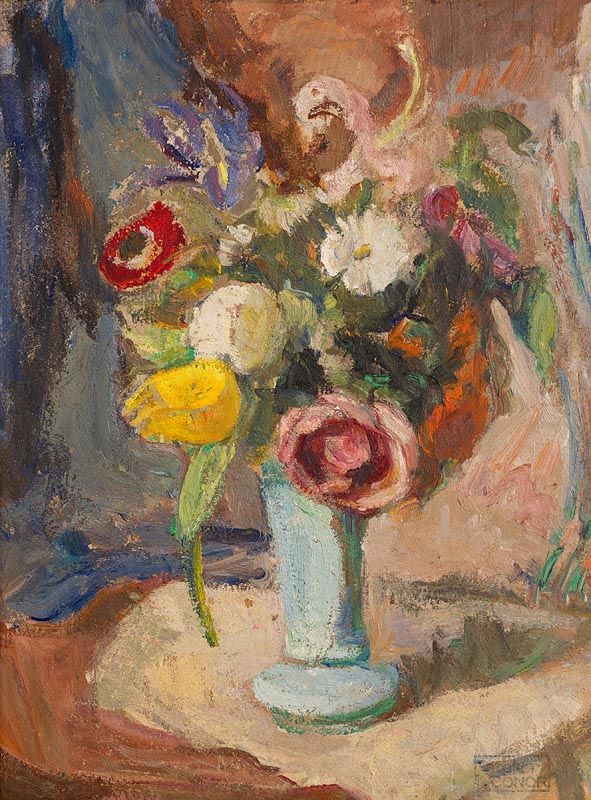
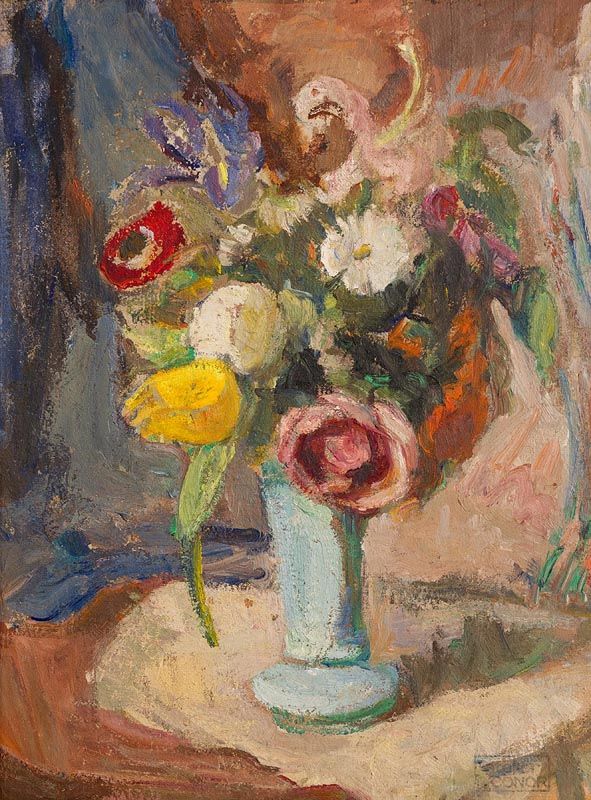
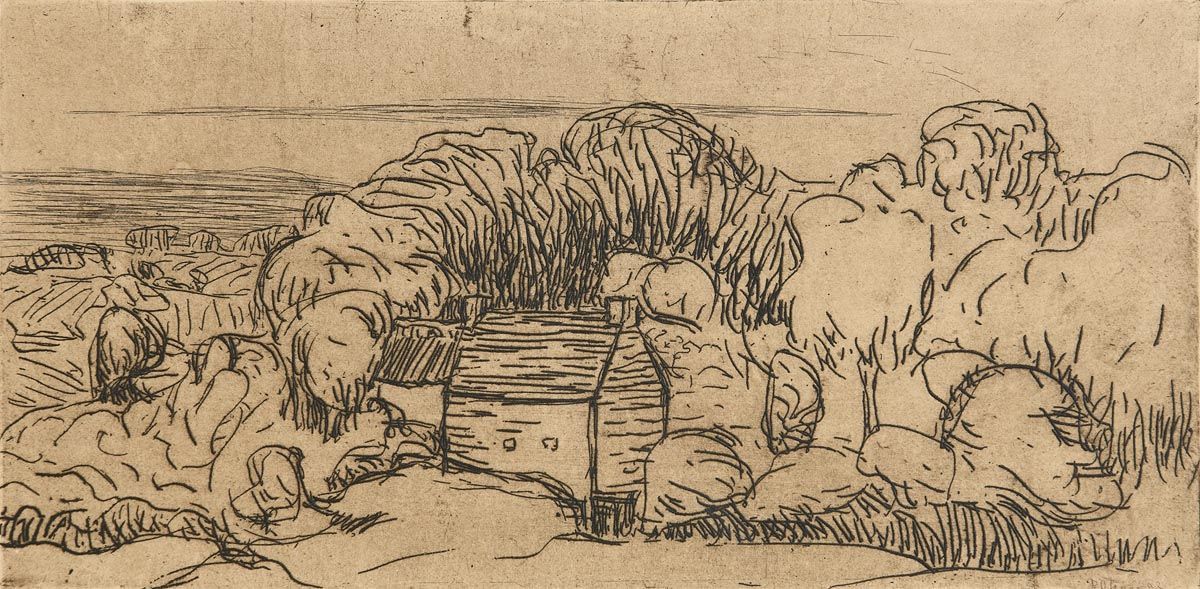



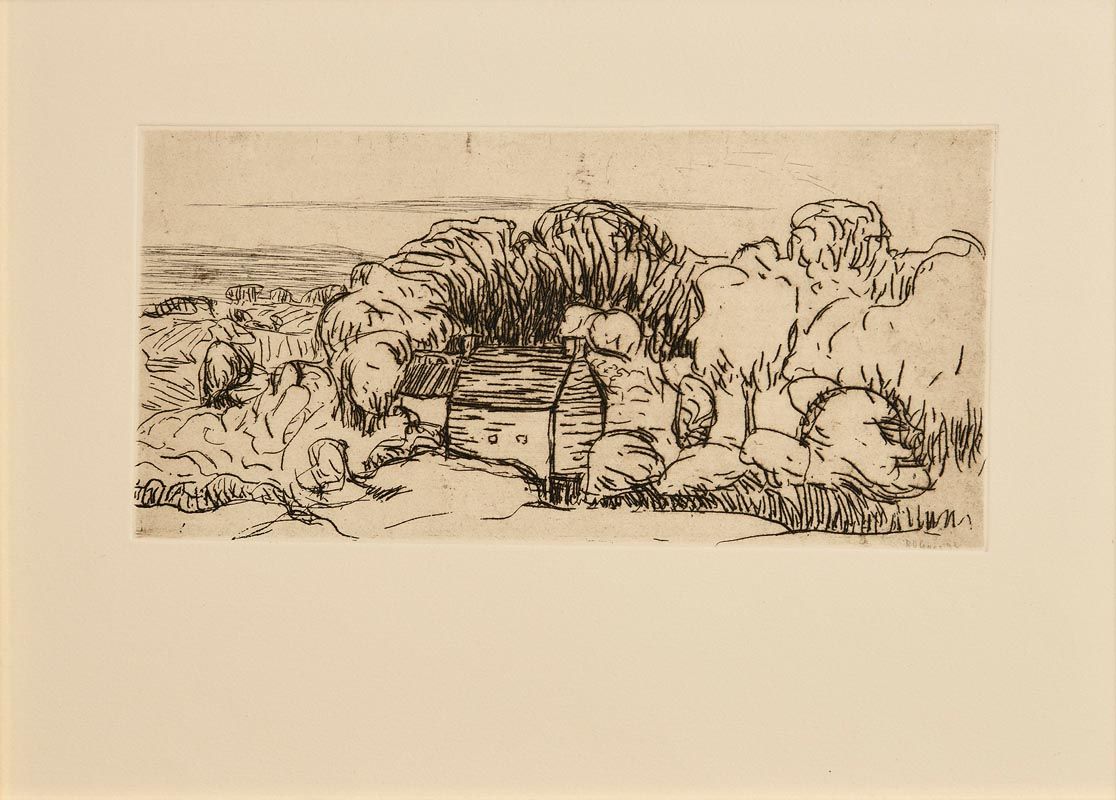
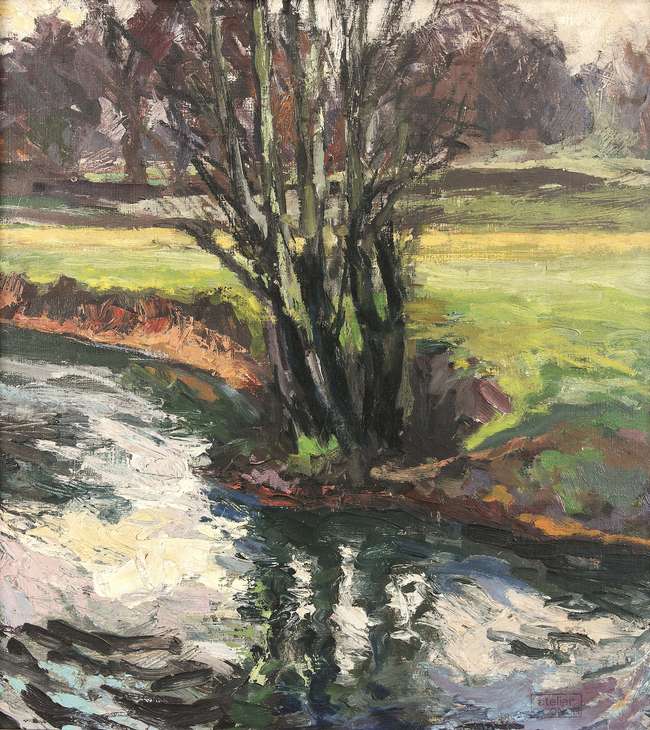
Try LotSearch and its premium features for 7 days - without any costs!
Be notified automatically about new items in upcoming auctions.
Create an alert